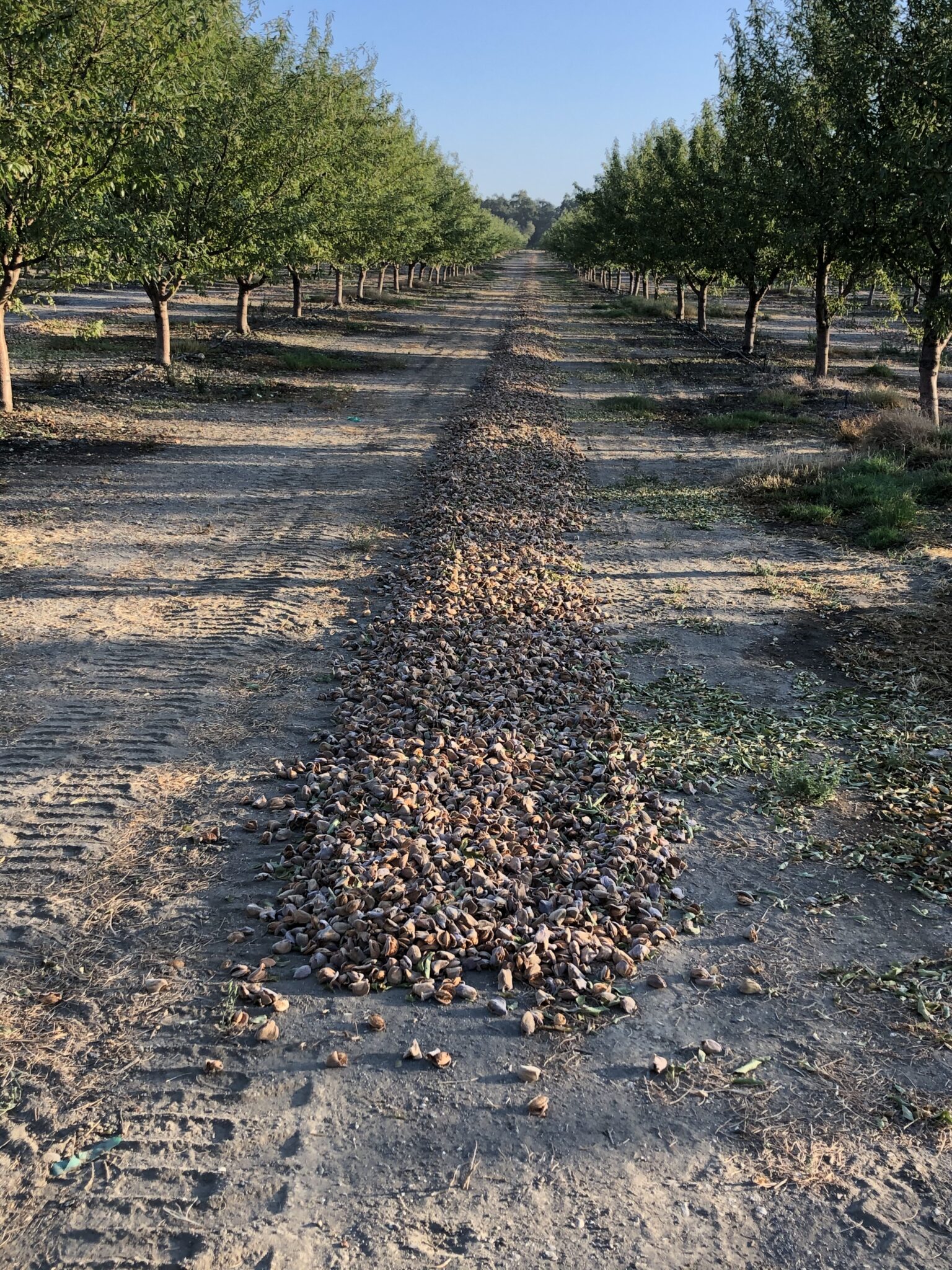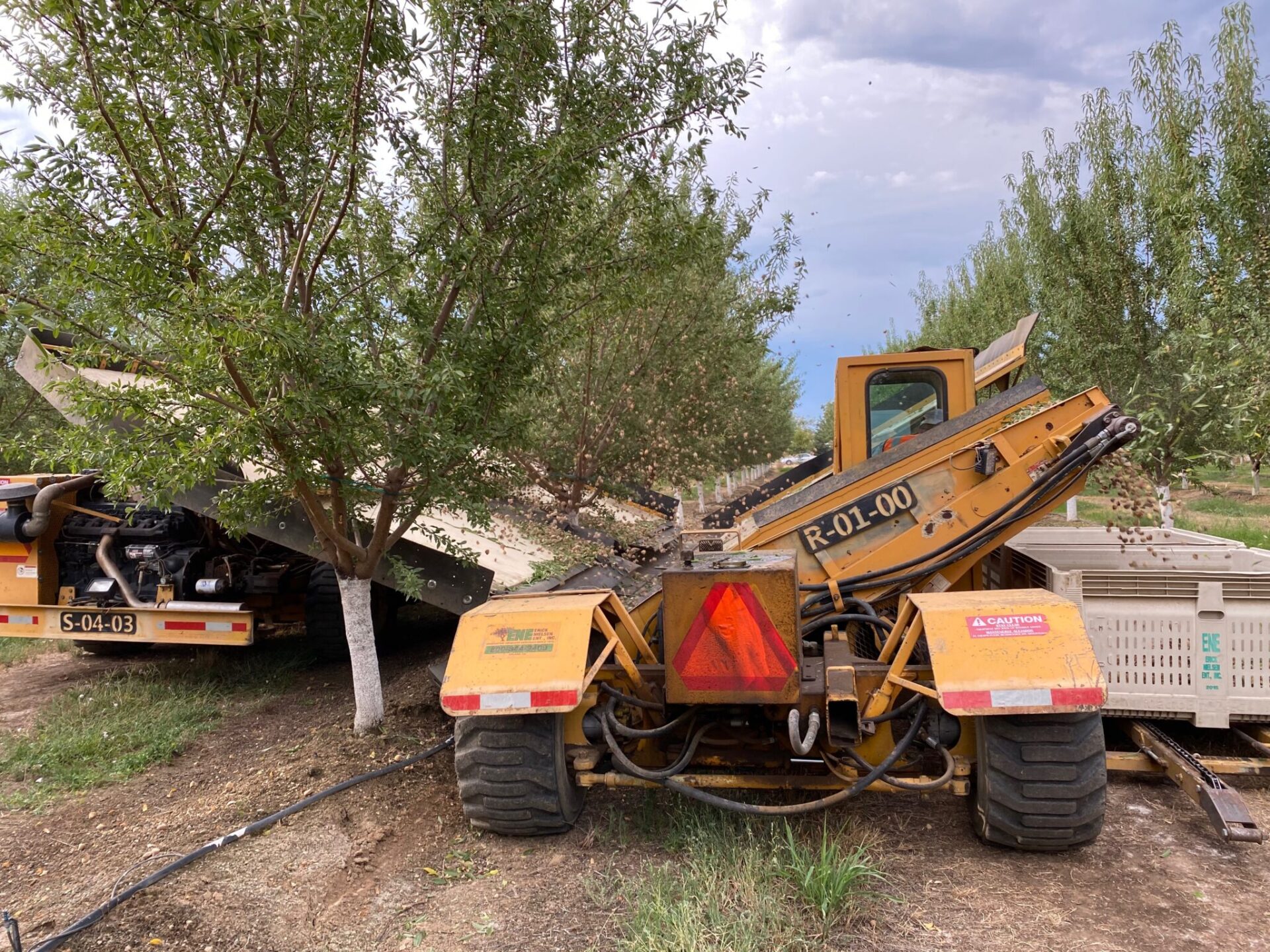Almond Board of California (ABC) and collaborating researchers are taking a two-pronged approach to dust reduction that involves harvesting and complementary crop drying methods. As part of the effort, they’re taking a closer look at eliminating blowing and sweeping and possible alternatives for in-orchard drying and nut pick-up. Altogether, these steps account for about 90% of harvest dust, according to the San Joaquin Valley Air Pollution Control District.
Just by following best management practices, California almond growers over the past several years have reduced the amount of harvest-related PM10 dust particles to 31 pounds per acre from about 40 pounds per acre, according to Texas A&M University research. PM10 particulates—10 micrometers or smaller in size—are about one-seventh the diameter of a human hair and are easily inhaled. PM10 particles are regulated as an air pollutant by the US EPA.
ABC wants to further decrease dust emissions and has set a lofty goal, announced in 2018, of reducing harvest-related dust by 50% by 2025.
The first part of the equation involves substituting a shake-and-catch harvester for the traditional sweeper. The second portion focuses on evaluating different drying techniques.
Getting Off the Ground
While two-piece side-by-side off-ground harvesters used by the prune and pistachio industries may come to mind, other companies have one-piece over-the-row types similar to those used in high-density olives or blueberries. Even as far back as the 1970s, one company had a wrap-around shake-and-catch harvester.
The designs may be divergently different, but the goals are the same – eliminate blowing and sweeping nuts into windrows on the orchard flood and, in some cases, get rid of nut pick-up altogether.
Erick Nielsen Enterprises Inc. of Orland, California, has been designing and building orchard equipment for nearly 50 years. Among their products are side-by-side shake-and-catch harvesters for prunes and pistachios. In addition, the Nielsens farm almonds and use their shake-and-catch harvesters in their orchards, said Hilary Porter, a company owner.
About eight years ago, the family-owned company began offering custom off-ground harvesting. Customers, for example, may have rocky or uneven middles where nuts could be lost or they may have a dense tree canopy that would shade the orchard floor and slow drying.
“Sometimes the growers just want to save passes, but we’re still windrowing in the field on the ground,” Porter said. “We’ve also done them where we’ve completely taken the nuts out of the field and windrowed them at a different site.”
Franz Niederholzer, a UCCE orchard systems farm advisor in Colusa, Sutter and Yuba counties, has had the Nielsens custom harvest an experimental block of organic almonds at the Nickels Soil Lab near Arbuckle since 2016.
He had installed a new buried drip irrigation system along the edges of the middles, creating an uneven surface. Niederholzer also shanks in nutrients, further disturbing the surface.
“The floor’s not that pristine,” he said. “The catch-frame system might be a great way to move your operation away from the need to have the orchard floor so smooth for harvest.”
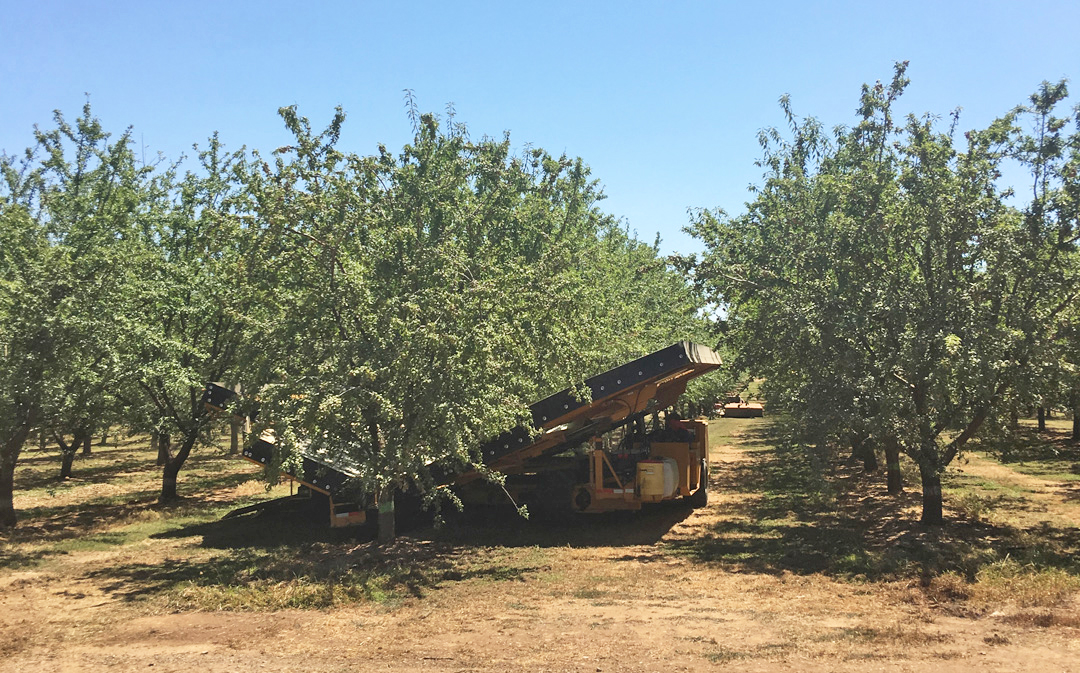
At Nickels, the Nielsens use a modified bin-style prune harvester that catches the almonds as they are shaken and lays them in neat windrows down the middles. To make sure drying is as fast as possible, the Nickels crew conditions the windrow soon after shaking so all leaves are removed and the windrow is clean and wide to facilitate drying. Then the windrows dry as they would during conventional harvesting. With the nuts immediately windrowed, the orchard is irrigated within two to three days of shaking.
For at least one other customer, Porter said they shake and catch the almonds, then transport the crop to a nearby cement yard where it is windrowed. Because of the orchard’s dense canopy, the nuts would be slow to dry if left on the ground.
At Nickels, the catch-frame harvesters did occasionally knock low-lying branches as they moved from tree to tree, and a small number of nuts on long branches were not caught and ended up as windfalls, Niederholzer said. Neither was a significant issue.
If the experimental block were developed again with shake-and-catch harvesters in mind, Niederholzer said the trees would be trained to be slightly more upright or select varieties with those characteristics.
Porter agreed, saying a higher tree crotch and higher scaffolding would allow the catch-frame harvesters to move more safely down the rows.
In addition, research by Ted De Jong, UC Davis pomologist emeritus, found a strong need for studies into size-controlling rootstocks. Along those lines, Porter pointed out how the pistachio industry has successfully developed cultural practices and canopy management, such as mechanical hedging and skirting, to produce trees adapted to off-ground harvesting.
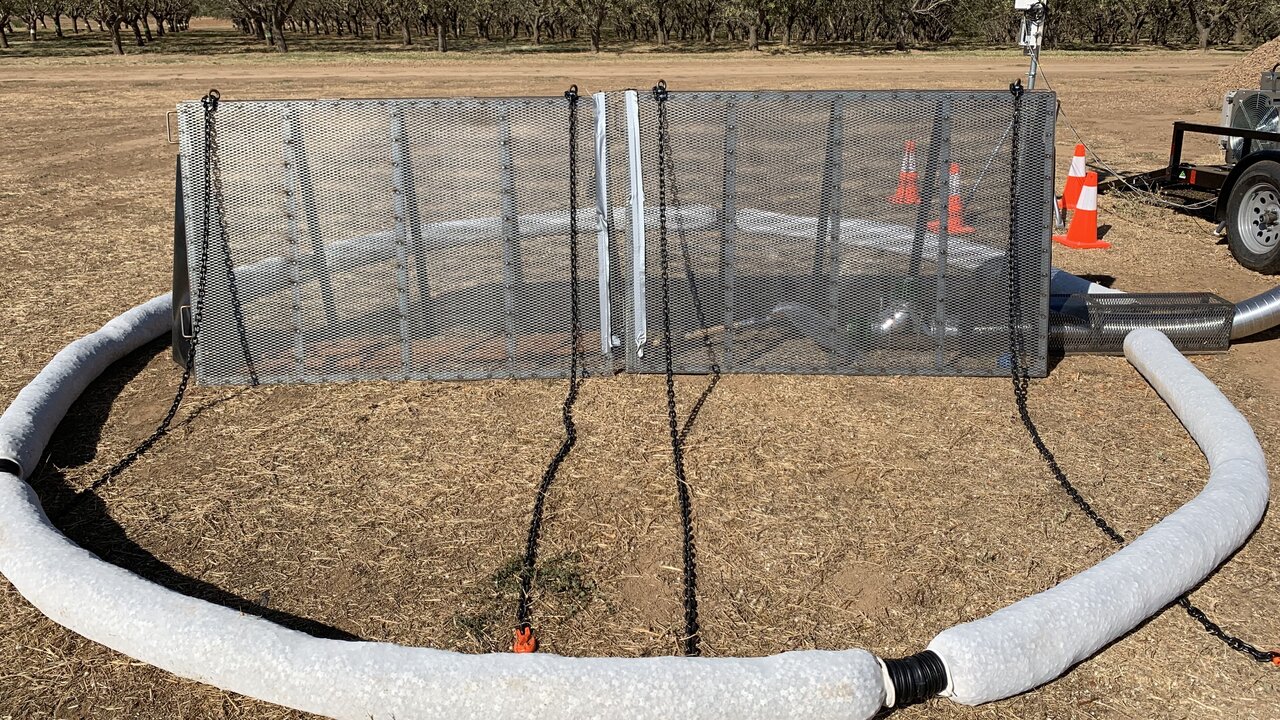
Different Drying Options
As part of multi-disciplinary efforts, Irwin R. Donis-González, a Cooperative Extension specialist in postharvest engineering at UC Davis, is working on stockpile drying techniques with counterparts in Australia. As a result, they’re able to obtain two sets of harvest data per year.
Zongli Pan, a UC Davis professor of biological and agricultural engineering, is conducting complementary research into alternative drying techniques in fixed structures, such as stadium and trailer dryers. As part of his work, he is examining temperature, drying rates, moisture at harvest, varietal differences and costs.
They recently presented research updates virtually.
The first harvest scenario involves harvesting almonds using a shake-and-catch harvester and simply depositing the nuts in a windrow to dry on the orchard floor.
The second scenario uses a shake-and-catch harvester, then ferries the nuts to a nearby drying yard. An initial trial involved creating a stockpile of nuts over an A-frame with air channels to take advantage of prevailing air flow. But the researchers found the system didn’t offer enough natural air circulation.
They also looked at different sets of stockpile drying systems to determine optimum air flow rates, air temperature and drying time.
During a 2020 trial in Australia with 20 tons of nuts, they found that a three-horsepower fan did not provide enough air movement to dry nuts harvested at 14% moisture.
“Ambient air, especially with wet fruit at 14% moisture, wasn’t able to efficiently and effectively remove the moisture from the stockpiles, and we observed problems with mold,” said Irwin R. Donis-González.
Another experiment used a two-horsepower fan coupled with a propane heater that raised air temperatures to 122 degrees F. An air distributor inside the stockpile A-frame had 12 air outlets from which the forced air moved.
Using this system, 5.2 tons of Nonpareil harvested at 12% moisture took six days and five hours to dry. A 2.8-ton stockpile of Winters at 12% moisture took six days, and 7.6 tons of Monterey at 21% moisture took seven days.
“We used the air distributor to force a combination of ambient and heated air to remove the nut moisture, and we reduced drying by about 50% compared to not using an air distributor,” Donis-González said. “But we still are averaging a five- to seven-day window regardless of stockpile size. The next step is to consider expanding the size of the fans so we can force enough volume of air through the stockpiles.”
The researchers will also be switching to covered stockpiles with central exits to try to manage uncontrolled drying fronts.
The third scenario involved the same off-ground harvesting method but instead transported the nuts to a commercial dryer.
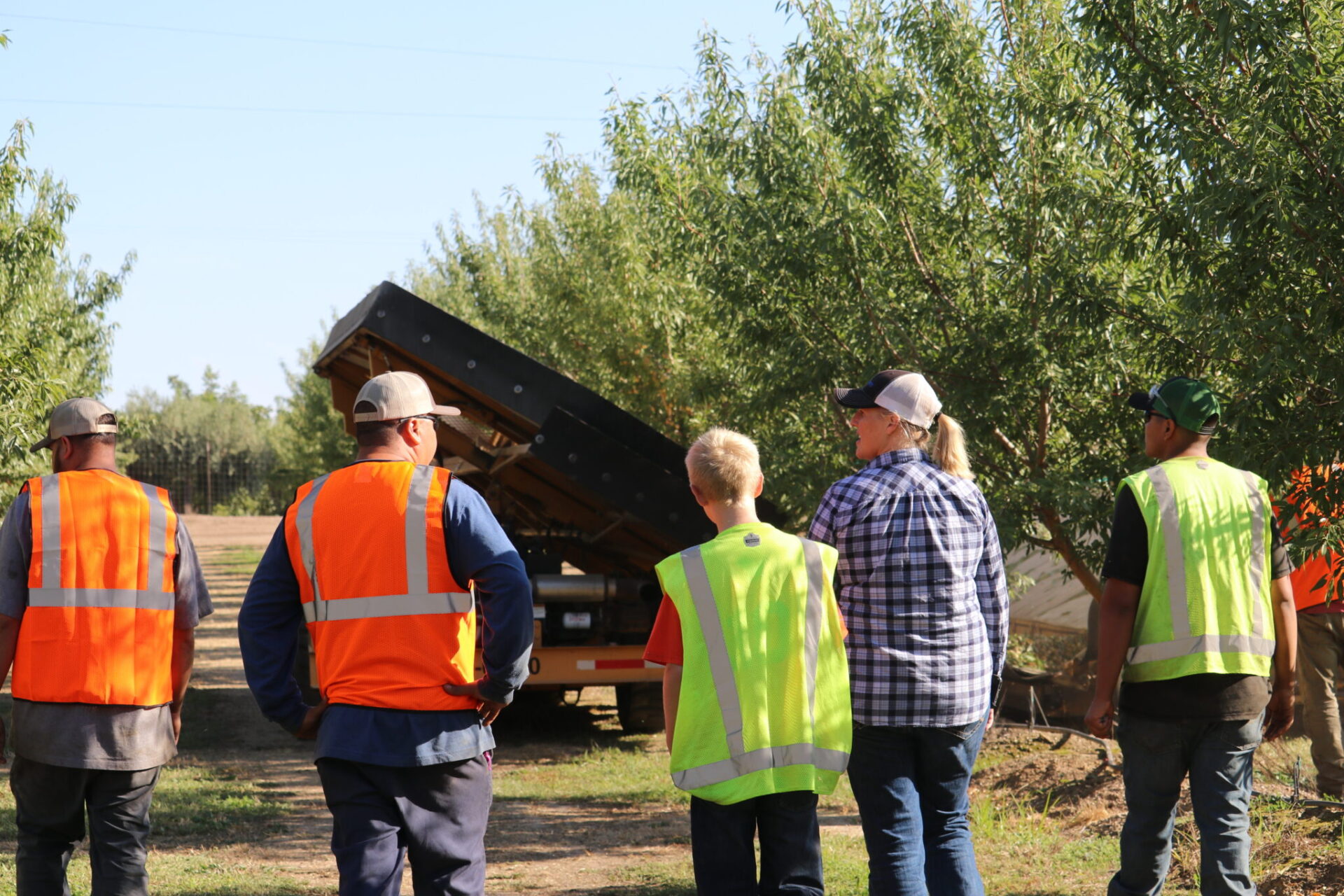
Earlier Harvest
The latter two harvest methods allow growers to shake trees two to three weeks earlier than traditional timing. This could potentially reduce late-season pest issues, including navel orangeworm damage and associated insecticide treatments, said Patrick Brown, a UC Davis plant sciences professor.
Yet trials conducted by Brown found that shaking two to four weeks earlier than conventional harvest timing did not compromise kernel quality or size.
“You can shake three weeks prior, and you’re not losing any statistically significant yield,” he said. “This isn’t surprising. You can go back 45 years to 1986, and they showed once you reach that B3 stage, you’ve reached the full kernel size.”
That said, kernel moisture tends to be 10% to 15% higher with a two-week earlier shake.
One of the biggest benefits Brown sees is the latter two harvest scenarios create opportunities for alternative orchard floor management, such as with cover crops or recycling almond hulls and shells.
Regardless of the harvest and drying scenario, a transition to any new system won’t happen overnight, but Porter said she remains optimistic that the industry will answer the challenge.
“There are just a lot of things being done. I think farmers are creative by nature,” she said.
